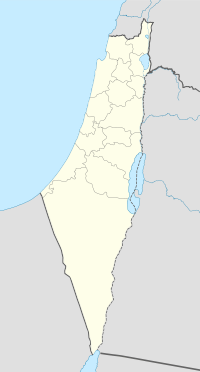Ghuwayr Abu Shusha
| Ghuwayr Abu Shusha | |
|---|---|

Maqam Sheikh Abu Shusha
|
|
| Arabic | غُويّر أبو شوشة |
| Name meaning | from personal name; meaning the “father of” wearing “a top knot” |
| Subdistrict | Tiberias |
| Coordinates | 32°51′13″N 35°30′34″E / 32.85361°N 35.50944°ECoordinates: 32°51′13″N 35°30′34″E / 32.85361°N 35.50944°E |
| Palestine grid | 197/251 |
| Population | 1,240 (1945) |
| Area | 8,609 dunams |
| Date of depopulation | 21 and 28 April 1948 |
| Cause(s) of depopulation | Military assault by Yishuv forces |
| Secondary cause | Influence of nearby town's fall |
| Current localities | Ginosar, Livnim |
Ghuwayr Abu Shusha was a Palestinian Arab village in the Tiberias Subdistrict. It was depopulated during the 1947–1948 Civil War in Mandatory Palestine on April 21, 1948. It was located 8 km north of Tiberias, nearby Wadi Rubadiyya.
In 1838 Edward Robinson found on the remains of a few dwellings, built of rough volcanic stones, some of which were still used as magazines by the Arabs of the plain. A wely with a white dome marked the spot. He found no traces of antiquity.
In 1850-1851 de Saulcy saw the village, which he described as ruined. Of the village, all which remained was a few portions of wall of modern appearance, "but in the midst of these is still standing a square vaulted tower, constructed in fine blocks of Herodian workmanship, or Roman of the early empire. This tower rests against a wall of more recent character."
In 1875 Victor Guérin visited and noted the little wely dedicated to Abou-Choutheh.
In 1881, the Palestine Exploration Fund's Survey of Western Palestine (SWP) described it as containing 20 Moslems, with housed built of basalt, located round a mill. There were modern ruins in the village, and a number of ruined mills in the valley below.
In 1945 it had a population of 1,240 Muslims, with 8,609 dunams of land. Of this, 21 dunams were used for citrus and bananas, 1,377 for plantations and irrigable land, 1,848 dunams for cereals, while 6 dunams were classified as built-up (urban) area.
The village also contained Khirbat Abu Shusha, which had the ruins of water-powered mills.
The village was depopulated after a military assault on 21 and 28 April 1948.
Ginosar presently occupy part of what was village land, so does Livnim, established in 1982 ca. 1 km northwest of the Ghuwayr Abu Shusha site.
...
Wikipedia

